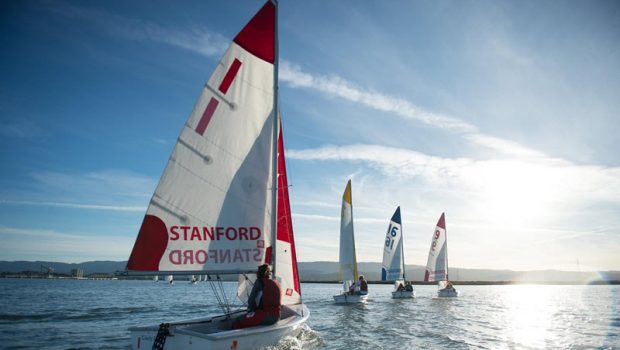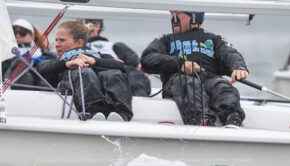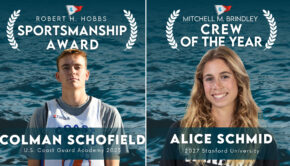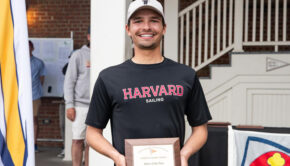The West Coast College Experience
Published on October 4th, 2017
For teenage sailors seeking to pursue collegiate competition, their school choices are often influenced by sailing programs with varsity status, as this status equates to the funding needed to compete at the highest level.
While these schools tend to be along the eastern corridor of the US, on other side of the country is Stanford University which has a long history of providing the tools needed to succeed, but the school hasn’t always had sufficient talent to succeed at the national level until recently.
Scuttlebutt editor Craig Leweck checks in with Stanford head coach John Vandemoer for an update.
California develops a lot of top young sailors, but with most sailing teams out west having club-status, they tend to go east to compete at a higher level. How is Stanford attracting top sailors to compete in the western conference?
First off, Stanford University is an incredible educational opportunity. And, I think we find, which is fantastic for our sport, that a lot of these young sailors coming up are really intelligent and really motivated academically. This has benefited Stanford and the Ivy League schools.
Over the last 10 years I’ve been at Stanford now, I have seen how students really want to push themselves academically and experience life beyond sailing, and have looked toward these top academic institutions for that fulfillment. This trend has not only benefited our program but perhaps also schools such as Dartmouth, Brown, Yale, and Harvard.
A lot of these kids that we’re getting are coming from the East Coast, are they are kind of doing the opposite thing that the West Coast kids are doing. They’ve had an East Coast experience and they want to see what it’s like on the West Coast. Certainly being able to surf and ski and get an incredible education at a beautiful place is a pretty attractive lure to them.
And varsity coaches have the ability, if needed, to ease entrance requirements?
Every school is a little bit different but, yes, generally that’s true.
For kids with Olympic aspirations, balancing that track with college, and college sailing, is an increasing challenge. I see Stanford has attracted a number of people in that category?
We’ve definitely seen an uptick of that, especially in the last five years. I think a big part of that is how Stanford is a huge Olympic supporter. Our school has had a very successful Olympic history, highlighted at the Rio 2016 Games where half the women’s swimming team that medaled were from Stanford. For the sailors in Rio, several also had Stanford ties.
But I wouldn’t necessarily say that Stanford is ‘Olympic-friendly’, but more so this is about the kind of people that Stanford attracts. For our sailing team, we want sailors that want to really achieve in their sport. This isn’t just about the Olympics, but rather how these people want to develop in their sport as far as possible.
Stanford attracts people that want to be the best possible version of themselves. So they’re looking at Stanford to provide those resources, whether it’s nutrition, sports performance, etc. While our sailing team program significantly contributes to their development, there are also many other assets at Stanford that can be utilized so they can develop into the best possible athlete they can be.
Is this a challenge for a sailing coach to have someone at Stanford that wants to be on the sailing team, but they also want to balance that with their own Olympic pursuits?
It is a challenge for both coach and sailors, though for the sailors it is not so much about balancing college and Olympic sailing but rather keeping the focus on their academics, especially at a school like Stanford.
I talk to all of our recruits in the same way that are interested in this path. If they are coming to school, they really don’t have the time to travel and go to all the regattas or all the training camps for the US Olympic team. But by being in school, this is a way for them to stay in touch with the sport, and learn different aspects of the sport, and become better.
For them the hard part is managing academics, and determining when is the right time to take time off, when is the right time to do that trip to Europe for some spring events in their Olympic sport. How does it work with your academics is really the biggest conversation I would have.
For these sailors with Olympic aspirations, and how we now recognize the importance for them to be training during their college years, do you find how college coaches are needing to be a little bit more flexible than in the past?
I think the flexibility has always been there. I don’t think anything really has changed from the mentality of the college coach. I think what’s changed is the increase of positive communication from the Olympic program.
The fact now is how there is an Olympic development team that’s truly working, which many of these young people are engaged in, and how that program is positively contributing to the Olympic team. So the college coaches have welcomed this increased communication; that’s been the real key which has opened up more opportunities.
I don’t know of a single coach that’s ever held someone back. They’ve just tried to be their best adviser possible.










 We’ll keep your information safe.
We’ll keep your information safe.